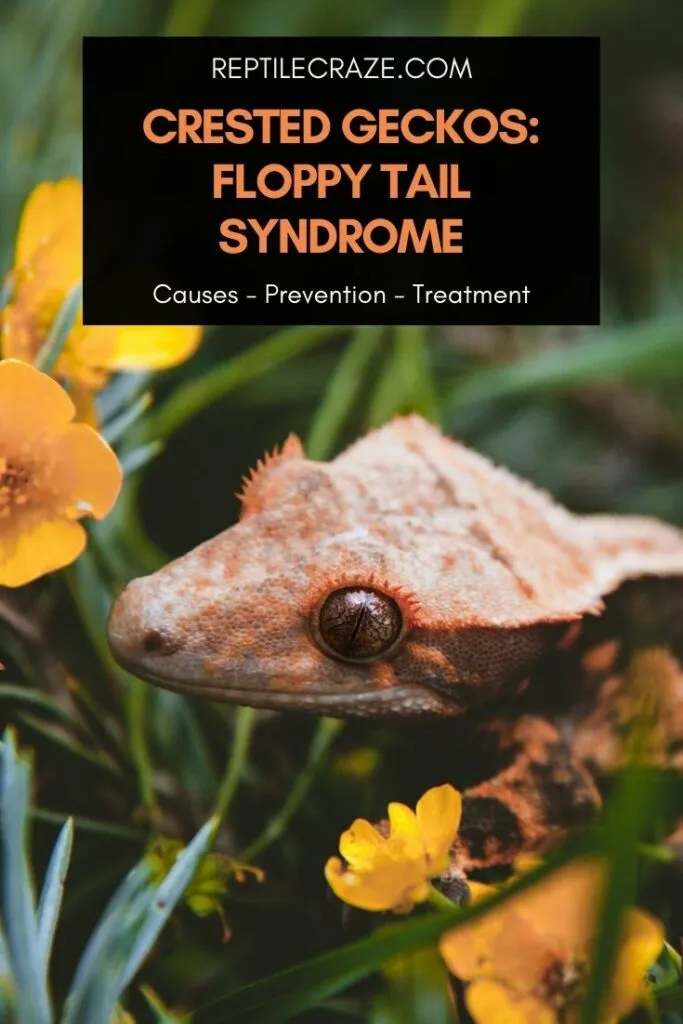
Have you ever seen a crested gecko – perhaps even yours – hanging upside down on their
This isn’t some new trick they learned, but a serious and damaging health condition commonly referred to as floppy tail syndrome.
Table of Contents
What Is Floppy Tail Syndrome?
Floppy tail syndrome (FTS), sometimes simply referred to as “floppy-tail”, is an often-overlooked health issue in crested geckos and various other lizards.
In healthy crested geckos (Rhacodactylus ciliatus), their tail will remain perpendicular to the glass if they’re upside-down on the side of their
Rather than just being a cosmetic issue that (some argue) can make a crested gecko “less attractive”, it can impact a crested gecko’s reproductive and overall health.
Therefore it’s very important to know everything you can about floppy tail syndrome, how to prevent FTS, and how to treat it to ensure that your crestie stays healthy.
In this article, we’ll take a deep dive into the symptoms, causes, prevention, and treatment or maintenance of floppy tail syndrome in crested geckos specifically.
What Are The Symptoms Of Floppy Tail Syndrome In Crested Geckos?
There aren’t a lot of symptoms that show that your crested gecko may be suffering from floppy tail syndrome.
The most common symptom is that your crestie’s tail can hang at a 90-degree angle to their body or that the tail “flops” to the side of their body in an unnatural position when they are upside-down.
This unnatural bending of their tail is also called “hyperextension”.
Other symptoms which are visible to the naked eye, include slight lumps or depressions around your crestie’s pelvic region. In severe cases, an actual deformity of the pelvis can be seen.
The more serious symptom of floppy tail syndrome is that your crested gecko may have difficulty defecating and/or laying eggs if it’s a female.
This difficulty is caused by the long-term effects of FTS that lead to your crestie’s pelvis twisting. This twisting can not only be painful, but can also lead to your crested gecko being unable to lay its eggs.
In some cases, your crested gecko may not be able to use its tail normally anymore, and wouldn’t be able to grip branches, for example, in the way it used to.
However, most of the crested geckos suffering from FTS do retain the full use of their tail.
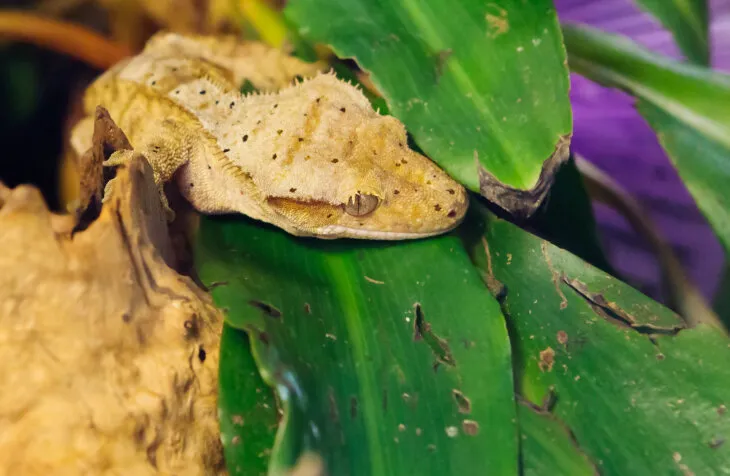
What Causes Floppy Tail Syndrome In Crested Geckos?
The exact cause of floppy tail syndrome in crested geckos doesn’t seem to be only one specific thing, but can be because of a combination of genetics, reduced bone density, and husbandry.
“Partial caudal autotomy” – or, incomplete “loss” of a crested gecko’s tail – has also been put forward as an explanation. Let’s look at each of these possible causes separately.
Genetic Causes Of Floppy Tail Syndrome
Although no specific genetic abnormality has been identified as the cause of floppy tail syndrome, the fact that it is quite prevalent in captive-bred crested geckos, suggests that there may be (at least partially) a genetic cause for FTS.
That is to say, cresties kept as pets come from a relatively small gene pool and this may have caused this abnormality to become so widespread.
When buying a crested gecko, you need to ensure that they come from a strong breeding pair that, themselves, haven’t been inbred.
This will ensure that your own crestie has a smaller chance of having a genetic predisposition to genetic abnormalities.
Some abnormalities – for example, pelvic abnormalities – may only become visible with age or even only through x-rays.
But, by buying only from reputable breeders, and not just anyone who’s let their cresties breed, or from crested gecko “mills”, you can be assured of there being little chance of your crestie suffering from a genetic disorder.
Floppy Tail Syndrome As A Symptom Of Metabolic Bone Disease
As with a genetic cause for FTS, there are also no conclusive studies that show that floppy tail syndrome is because of metabolic bone disease.
Metabolic bone disease (MBD) is a horrible disease that is caused by a crested gecko not getting enough calcium in its diet.
Because there isn’t enough calcium in their diet, crested geckos’ bone density is decreased, which means that their bones break easily.
Metabolic bone disease cannot be cured and leads to a slow, horrible death of cresties and other reptiles. It is plausible that MBD can be one of the causes of FTS, especially in extreme cases.
However, many other symptoms of metabolic bone disease would also be present if FTS is because of MBD.
Many of the crested geckos that suffer from floppy tail syndrome don’t have a calcium deficiency – especially not one dire enough to cause metabolic bone disease. It’s therefore unlikely that MBD is a culprit in all or even most FTS cases.
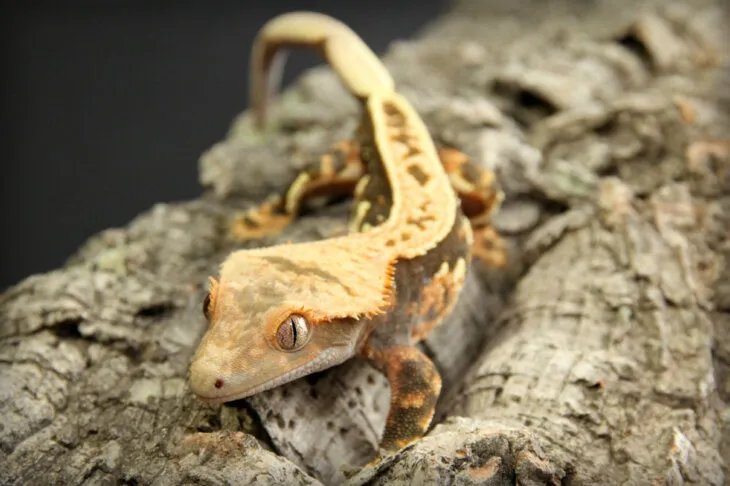
Reduced Bone Density As A Cause Of Floppy Tail Syndrome
Bone density can, however, be caused by genetics as well – and can be passed on, especially through the inbreeding of crested geckos.
If the bone density of a crested gecko is not at a healthy level, their bones are more prone to breakages.
These breakages can occur anywhere in the body, but a break in the tail or damage to the pelvis and pelvic girdle, could be attributed to reduced bone density in certain cases.
Again, however, there are no conclusive studies that show that FTS is only caused by reduced bone density.
Partial Caudal Autotomy As A Cause Of Floppy Tail Syndrome
Crested geckos, like many other reptiles, are able to self-amputate or “drop” their tails when they are in danger. (Unlike other geckos, however, crested geckos can’t grow another tail.)
If their tail is only partially amputated, this is known as partial caudal autotomy and some believe that this is what happens when a crested gecko suffers from floppy tail syndrome.
Although this may explain some of the instances in which a crested gecko’s tail “flops”, it cannot account for all the cresties who get FTS.
Some experts have also commented that, if partial caudal autotomy takes place the tail will most likely not receive the blood that it should and will turn gangrenous. (Should this be the case, get your crestie to the vet immediately.)
Another, unlikely, explanation for FTS in crested geckos is that the adult crested geckos simply aren’t “designed” to carry a heavy tail.
Because crested geckos don’t regrow their tails after dropping them, most adult cresties in the wild don’t have tails.
According to this explanation, FTS happens because of the weight of the tail in pet crested geckos.
Husbandry As A Cause Of Floppy Tail Syndrome
Finally, let’s look at husbandry as an influence or cause of floppy tail syndrome in crested geckos.
Husbandry – or how you keep and care for your crestie – is extremely important to keep your crested gecko happy and healthy.
When cresties aren’t properly cared for, they can develop any number of health conditions.
Your Crested Gecko’s Tank Setup
How your crested gecko’s
One of the causes of FTS – or that can exacerbate the condition – seems to be crested geckos sleeping upside-down on their tank’s glass.
It could also be that they spend a long time in this position even when they’re not sleeping.
This can be remedied by changing the
Keep reading to find out what changes you can make to your crested gecko’s
Treatment Options For Floppy Tail Syndrome In Crested Geckos
Floppy tail syndrome can be managed quite well at home in its initial stages, but if your crested gecko’s tail flops to a 90-degree angle and/or they have difficulty defecating or laying eggs, you need to take them to a vet that can treat exotic pets like cresties.
Your treatment options may, however, be limited.
One of the most popular treatments for floppy tail syndrome is amputation of the tail. As crested geckos can self-amputate their tails, this is a relatively easy procedure to do.
However, even though it’s “easy” doesn’t mean you should try it at home. Let the professionals do their job.
When the weight of the tail is removed, your crested gecko shouldn’t be troubled by worsening spine or pelvic deformity.
Because cresties have evolved to cope without their tails – as they lose them all the time in the wild – you don’t have to worry that they’ll struggle to hunt, climb, etc. Just give them a day or two to get their full balance back.
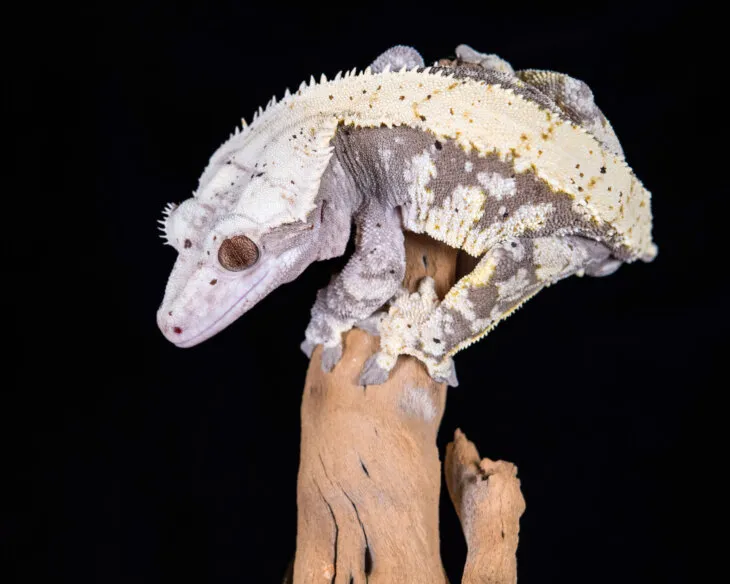
How To Prevent Floppy Tail Syndrome In Crested Geckos
Of course, prevention is better than cure, so let’s look at ways in which FTS can be prevented – or at least managed.
Calcium And Other Supplements
As we’ve mentioned, a lack of calcium in your crested gecko’s diet may impact their bone density.
To find out how much calcium to feed your crestie, head over to this article on crested geckos and calcium supplements.
You should also ensure that your crestie gets all the vitamins and minerals that they need in order to stay healthy.
Your Crested Gecko’s Tank Setup
Besides getting the basics right regarding temperature and lighting (here’s an article to help you set up your crested gecko’s
This is done by giving your crestie a lot of stimulation through the objects and plants in their
We here at RetileCraze are firm believers in giving your reptile the best and closest to nature enclosure to ensure that they live their best lives and don’t get bored of seeing just one plastic plant and hide on bare tile or reptile carpet.
Giving your crestie lots of plants to climb on, will ensure that they have somewhere else to sleep if they’re not in the mood to sleep in one of their hides.
Talking about hides, make sure that the hides that you supply for your crested gecko aren’t too hot or cold (or both) for them to be comfortable in.
Remember that they regulate their temperature according to the ambient temperature and, therefore, you need to give them a temperature gradient in order for them to cool down or get warmer as needed.
Tip! It could be that your crestie is sitting on the glass because they’re trying to get away from the heat or cold in their
tank , so make sure that the gradient is 100%.
You can also rearrange the plants and hides in the
You can also swap out fake plants for real plants that aren’t dangerous for crested geckos. If you’re unsure about the plants you can use, read this article on safe plants for crested geckos.
Making sure that some of the plants are close to or even touching the
Just ensure that you leave enough space for your crested gecko to comfortably move around in and don’t fill up all the space with plants and hides!
Wanna know what plants you can use in a crested gecko tank? Check out this article!
Exercise For Your Crested Gecko
By giving your crested gecko enough exercise, you will also keep them from being bored (or getting overweight for that matter!).
The last thing you want is for your crestie to just sit around and stare at the ground until they get their next meal. This means that you need to spend time with your crestie.
When you handle your crested gecko, they do get other sensory stimulation, and you can also teach them not to sit upside down on the glass by picking them up and placing them somewhere else in the
The problem with FTS will come if you simply leave them in the upside-down position for hours on end.
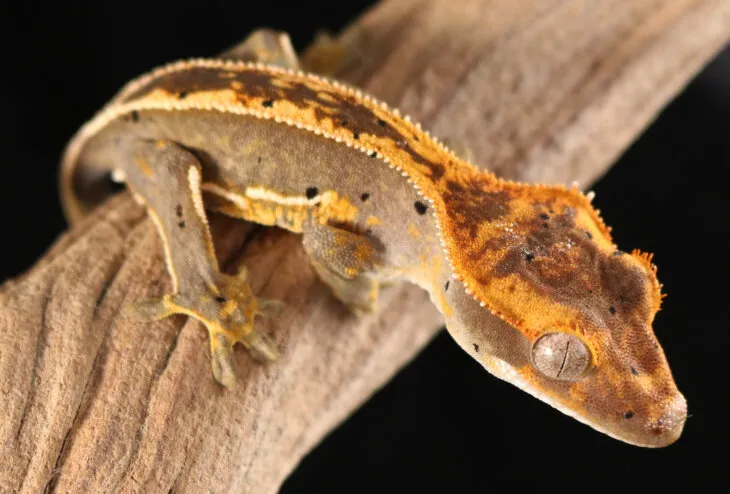
Is Floppy Tail Syndrome Reversible?
If your crested gecko already suffers from floppy tail syndrome, you’re probably wondering whether there’s anything you can do to reverse it, especially if the tail flops back a full 90-degrees or is causing them other health complications.
The bad news is that it cannot be reversed, especially if it’s already progressed to where your crestie is battling with defecation, etc.
However, if you catch it early enough, you can manage it so that it doesn’t get any worse. Do this by following the steps that we’ve given above regarding the
Note! If your crested gecko is in any distress, take them to the vet immediately. Don’t try to “fix” floppy tail syndrome on your own.
Can Crested Geckos With Floppy Tail Syndrome Be Used To Breed With?
Crested geckos with floppy tail syndrome should not be used for breeding. There are a number of reasons for this:
- Crested geckos with FTS may struggle with or be unable to lay eggs. If the gravid female is unable to lay the eggs, they could die if surgery isn’t performed in time.
- The eggs of a gravid female may put too much stress on already fragile pelvic bones and the eggs could cause severe damage even before they’re laid.
- It’s not yet clear whether FTS is genetic and therefore you could be passing on problematic genes to the next generation of cresties if you breed crested geckos with floppy tail syndrome.
Conclusion
Cresties are a joy to keep as pets but, just like more common pets, they need proper care in order to thrive.
Now that you know the steps you can take to keep your crested gecko from getting floppy tail syndrome, and how to manage FTS if they already have it, your crestie can look forward to better health and spending lots of time with their forever human.
- Enchi Ball Python: A Unique and Stunning Morph of Python regius - March 27, 2025
- Emerald Tree Monitor: The Enigmatic Green Guardian of the Rainforest - March 26, 2025
- The Egyptian Cobra (Naja haje): A Fascinating Serpent - March 25, 2025
